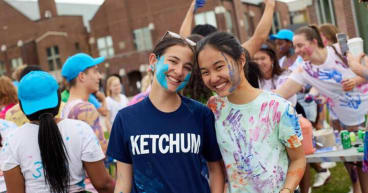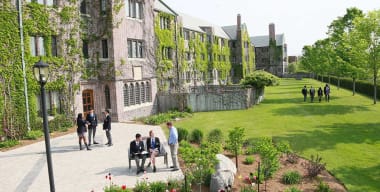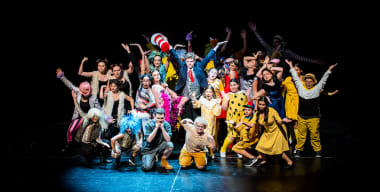The Importance of Learning Through Play Dating back to Jean Piaget's research and major contributions to Constructivism, a learning theory based on the premise that students can learn and test their knowledge through first-hand experience interacting with their environments, many educators have grown to understand the importance of learning through play in a child's development. Children have a natural curiosity towards the world around them, and naturally find meaningful ways to understand it. Throughout the last decade, educators and researchers have worked to find the most effective ways of taking what we know about how children learn, and putting it into practice. This has lead Ontario's Ministry of Education to implement full-day Kindergarten, with an emphasis on play-based learning. As discussed in my article on the importance of developing the early-learner's brain, children are born with 100 billion neurons, and each neuron sends information to thousands of other neurons in the brain through connections called synapses. During the early years of a child's life, synapses are rapidly forming and being destructed, based on the child's experiences. For example, if a young child realizes that holding onto a banister as he climbs the stairs helps with stability, he will form a synaptic connection which will inform his future decisions of how to successfully climb the stairs. Every time he climbs a different set of stairs and realizes that holding onto the banister makes his feat more successful, he will create new synapses which will help him generalize this newly formed knowledge to new and different circumstances. In the kindergarten classroom, play-based learning is not only a highly effective method for teaching and reinforcing academic concepts such as adding and subtracting, colour theory, and literacy, it plays an integral role in developing children's higher cognitive abilities such as decision-making, planning, and self-regulation. The Early Learning for Every Child Today (ELECT) document describes self-regulation as an important skill allowing the child to establish intrinsic motivation for understanding and adapting to social and emotional demands, as opposed to simply complying with external authorities.
How Play-Based Learning Affects Children Later in Life Promoting effective decision-making ability early on has implications for making healthy decisions later on in life allowing the development of the ability to take in pertinent information about the decision in question and using prior knowledge to properly inform this decision. For example, when presented with the chance to cheat on a test, a child who had the opportunity to develop her decision-making skills early in life will consider the consequences of cheating such as the feeling of guilt, suspension, and a potential mark of zero. In contrast, a child who did not properly develop decision-making skills, may only consider the immediate emotions including fear of failure and the desire for a good mark. Now that the importance of play-based learning is clear, how can educators use this knowledge to better-develop their students? The use of centres is most often used in early learning classrooms, to help promote play-based learning. However, in order to ensure centres are being used to effectively teach students key concepts, and to give students meaningful experiences, it is imperative that certain considerations be made when constructing these centers.
Here are 5 Must-Haves of a Cognitively-Effective, Play-Based Center:
-
- Centers must be Meaningful and Deliberate:It is imperative that centers surround topics and ideas that are meaningful to each student. Additionally, always make sure you have a learning goal in mind for each center. If you have a play dough center in your classroom, make sure you have a learning goal that will be addressed through the interests of your students, and that it is in fact being met through this center. To create further meaning within a center, create a goal or challenge for the students to achieve. Perhaps have directions for students to make their own playdough. Have large written and pictorial instructions explaining how the students can independently make playdough. Then, it is important for you to give them a goal that will be meaningful for them, by tying the activity into what they have learned during whole-class instruction. This goal could be creating the letter of the week with the play dough, or to create a specific colour of play dough, by mixing primary colours. Learning opportunities: solubility, colour theory, fine motor skills, communication skills, reading, letter study, self-regulation. At the Mabin School, teachers are always listening for what sparks the interests of their students, to help inform their teaching. After a student in JK discovered an empty birds nest, the teacher took this opportunity to open up the study of birds. After studying real nests, students had the opportunity to create their own- this makes for a meaningful, and very effective center!
- Teachable Moments:In order to ensure your students are getting the most out of these centers, take time to really observe the students, and to ask follow-up questions. When you hear a student yell out, Look! I just mixed the red and yellow play dough together and it made orange! That's the time to ask, what would happen if you added more yellow?Learning opportunities: Extending prior or new knowledge, through deeper and more generalized application, cognitive flexibility
- Integrate meaningful Literacy into ALL centers: As literacy is the primary area of focus in development of the early learner, students must practice their reading, writing, and oral skills in as many different contexts as possible. For example, oral and reading skills can be exercised in the building centre, where students will have to work together to address the given challenge, perhaps creating a structure over one meter tall, through strategizing and problem solving. Students will have to read the instructions, and will use communication to reach a meaningful goalwhile exercising skills in measurement, 3D rotation (a higher cognitive function), and shape. If studying a unit on food, create a restaurant, or supermarket, where students can make lists, take down orders, or read a menu. The possibilities are endless! Just remember, connect your centre to a class theme or something you know will be meaningful for each and every child in your classroom. Learning opportunities: Expressing ideas orally, incorporating ideas from others to better inform their own, following instructions, reading, writing, counting, measurement, planning, and self-reflection
- Provide opportunities for students to observe Cause and Effect:Are you more likely to remember that a solute (such as salt) can lower the freezing point of water through someone telling you, or through experiencing this phenomenon? Most people will say the latter. Providing your students opportunities to observe how one condition or item can affect another, is an effective way to teach not only simple concepts such as colour theory, but concepts such as solubility and phase change. If you are studying water in your classroom, a great center can include this more advanced phenomenon by having the children place an ice cube in water, laying a string on top, followed by sprinkling salt on top of the string and ice cube, and waiting for 20 seconds (for the ice to reform). The string will stick to the ice cube and they will be able to lift the ice out of the water. Other Cause and Effect centers can include the study of spiders, butterfly larvae, terrariums, etc. Create an observation center, where students can watch real-life processes take place. Create observation sheets which lend themselves to your students levels of development. For example, provide bar graphs to colour if counting how many cocoons, larvae, and butterflies have developed. Additionally, ensure there are books and written vocabulary words around this center for students who want to try to label observation diagrams, or even write sentences! Learning opportunities: Life systems, scientific processes, graphing, solubility, writing, oral communication, and reading
- Ongoing Changes and Assessment:Students will eventually reach their peak of learning for a center. For this reason, it is important that the center provides new challenges when necessary. If students are studying colour theory at the water table by adding primary colours to create secondary colours, eventually, students will understand all they can about how red and blue make purple, blue and yellow make green, and red and yellow make orange. Once your students reach this point, think about what you can add to or change about the center to add a new, but related learning experience. This is where ongoing assessment becomes so important. Ensuring that you are constantly keeping running records and anecdotal reports, allows you to inform your own teaching, and therefore, your centers. Sometimes we can figure out the next step through listening to our students. Listen for comments which begin with, "I wonder what would happen if." Take these comments, and use them to provide your students with opportunities for them to answer their own queries. Some students may ask in this case, I wonder what would happen if we mixed purple with yellow, or I wonder what would happen if we mixed yellow light with red light, instead of using the water. Grab onto these opportunities for learning, as they are the best kind!Learning Opportunities: Extending newly obtained knowledge through deeper/more complex, and more generalized learning experiences
Havergal College kindergarten teachers have created and implemented a two-year, child-centered program that applies play-based learning through Literacy, Mathematics, and Science centers. These teachers continuously observe student work at these centers, documenting and learning through the use of anecdotal notes, recorded conversations, photographs, and video. Remember, that when an experience is meaningful, you are promoting cognitive development through increased synapses (connections) in the brain. Although play-based learning is extremely effective for children during the early years, a similar approach, called inquiry-based learning can be implemented as children grow out of this phase, to continue an exploratory method of learning. For more information on play-based learning, the Ontario Ministry of Education provides a detailed curriculum document on the benefits and methods of full-day learning, with a primary focus on Play-Based Learning.
For more ideas on how to implement effective centers or play-based learning in your classroom, you can contact me at [email protected]. To learn more about play-based learning, read our comparison guides: play-based vs. academic preschools and play-based vs. Montessori preschools.









